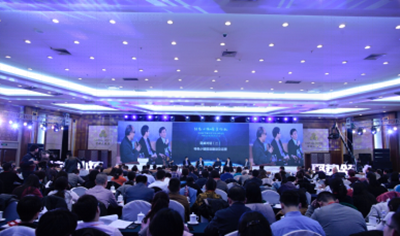By Qian Ding, CCTV.com editor
China's New Urbanization Development Forum--Characteristic Towns Cooperation Meeting was held on March 24 in Beijing, which was organized by Economy & Nation Weekly magazine and supported by Outlook, a think tank affiliated with Xinhua News Agency.
Wu Liang, CEO of Outlook think tank; Zheng Xinli, Executive Vice President of China Center for International Economic Exchanges; Han Bing, Vice Director of China Finance Ministry PPP (Public-Private Partnership) center; Zhang Hongyan, President of Institute of Urban Science, Nanjing University; Liang Xiongwen, General Manager of Time Industry and other representatives from local governments and companies were in attendance.

Characteristic Towns Cooperation Meeting (photo/ Qian Ding)
Beijing proposed implementation of supply side structural reforms and revitalization of the real economy, put forward constructing 1000 towns with distinctive characteristics nationwide by 2020 to achieve industrial upgrading.
By the end of 2015, 56% of China's total population had turned into urban dwellers, a dramatic increase from 26% in 1990. China's achievement in urbanization is acknowledged worldwide.
Nonetheless, the growing gap between rich and poor; severe pollution; high real estate prices have inflicted serious repercussions. Young migrants find it difficult to settle down in Chinese mega cities such as Beijing and Shanghai, but they don’t want to return to their hometowns.
In the cities, migrants can get better jobs, but must endure low quality of life, whereas the living circumstances at home, while stable with family roots, could be even worse and without good job opportunities. Many young migrants in Chinese mega cities, are asking themselves, whether to leave or not to.
The 1000 towns plan is hoping to provide a solution. Situated near the first tier cities or relatively developed second-tier cities. Each town covers an area of one to three square kilometers and is usually less than an hour's drive from central cities.
It boasts characteristic industries with one or more complete industrial chains, and provides diverse amenities including education, medical care, business, culture, entertainment, leisure and living space, which cater to needs of industry chains and people.
Combining the features of industry, town, humanity and culture, the town should be smart, eco-friendly, vibrant and futuristic.

Dachang Film Town, one of the characteristic towns newly built in 2016 (photo/ Internet)
Sounds good? But it is not an easy task to accomplish. With the slowdown of China's economic growth, it's harder to sustain China's huge investment in infrastructure, which accounts for much of China's GDP.
We have seen the opening up of Chinese ghost towns, such as the Kangbashen New District in Erdos, Inner Mongolia Autonomous Region and Rushan Silver Beach in Weihai, Shandong Province. High-rise apartment blocks have mushroomed, but they are largely empty, since authorities failed to attract new residents. How can we prevent these 1000 towns from getting deserted?
According to Zhang Hongyan, President of Institute of Urban Science, Nanjing University, the success of the characteristic town is based on reconstruction of local culture. The financial investment is important, but what's more crucial is to bring back the "cultural roots." The town should be built to serve people, provide more job opportunities and ensure a better life for people.
It needs to attract people in its own way, such as Silicone Valley of the United States, which is known for its technology and Davos, a picturesque town in Switzerland, which became known to the world for the World Economic Forum. And similarly, China's Boao, a town in southern Hainan province, is famous for the Boao Forum for Asia. The town needs to be unique to be appealing.
Wonderland Amusement Park, Nankou Town, in Changping District of Beijing, lies abandoned, even though it has Disneyesque castles, Thames Town in Shanghai with mock-tutor buildings and red phone boxes that has transformed into a place only for taking wedding photos. They stand forlorn because they are not original.
In 2015, I visited Williamsburg,Virginia in the United States, the city's tourism-based economy is driven by Colonial Williamsburg, the restored historic area of the city. The historic triangle which includes Williamsburg, Jamestown and Yorktown attracts more than four million tourists annually.

(Photo/Qian Ding)
This historic area is an interpretation of a colonial American city, with exhibits dozens of restored or re-created buildings related to its colonial and American Revolutionary War history. Costumed employees work and dress as people had done in the era, and it makes you feel like you returned back at that time, and it's still one of my favorite travel experiences.

Costumed employee and author (Photo/Qian Ding)
America is appealing in its own way and so is China. The problem with China's urbanization is that it tends to assimilate everything and the interests are not equally shared. Although China is a country rich in history and cultural diversity, many cities look so similar. Cultural confidence is the key to build on something original. The towns to be built must serve the people, not just for investment's sake.

Characteristic Towns Development Association was founded at the forum
The forum demonstrated a hardworking spirit, unity and open-mindness. Government officials, entrepreneurs, scholars joined together to discuss all possibilities and how to develop China's characteristic towns better.
The audience could participate in the online forum group by WeChat. Outlook think tank will cooperate with local governments, companies, schools and other organizations to visit Chinese towns, summarize the practices of towns construction and finish the writing of Report of China Characteristic Town Planning Development.

Qian Ding is an editor of Panview, she attained Masters of International Relations and International Communication in Macquarie University,Sydney, Australia.
(The opinions expressed here do not necessarily reflect the opinions of Panview or CCTV.com)

Panview offers a new window of understanding the world as well as China through the views, opinions, and analysis of experts. We also welcome outside submissions, so feel free to send in your own editorials to "globalopinion@vip.cntv.cn" for consideration.















